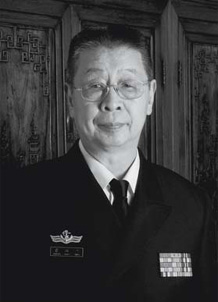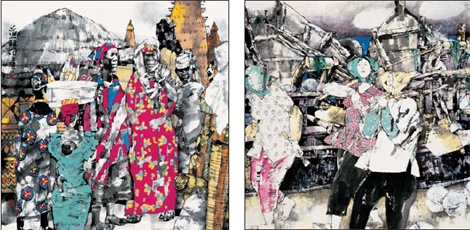'Army Painter' marshals forces of modern calligraphy
Born in Cangxian county in Hebei back in 1935, Zhang Daoxing is now deputy director of the Art Committee of the China Artists Association. As an officer of the People's Liberation Army and an artist in the Political Department of the Navy, Zhang is often referred to as the "Army Painter".
Zhang's early work was significantly influenced by the New Literati wave, which often borrowed from ancient Chinese literary works as a source of inspiration.
Zhang is especially fond of poems from the Tang Dynasty (AD618-907), and often uses horses as the theme of his paintings. "Figures Inspired by the Poem of Li He in Tang Dynasty" is one such equine-related work.
His profound skills in Chinese painting, calligraphy and seal cutting have built Zhang's reputation across the country and, latterly, throughout the world.
Zhang has held solo arts exhibitions both at home and abroad. His high-profile showings include Zhang Daoxing Chinese Painting Exhibition (Hong Kong, 1990), Zhang Daoxing Calligraphy and Painting Exhibition (Malaysia, 1994) and the Zhang Daoxing Calligraphy and Painting Exhibition (Beijing, 1995). In 1997, Zhang also participated in the Chinese New Artists' Works Exhibition in the New South Wales territory of southeastern Australia.
Due to his outstanding painting skills and profound understanding of the art world, Zhang has won a number of awards and seen many of his works collected by the National Art Museum of China.
Zhang is known for striving to maintain a delicate, harmonious balance between tradition and innovation, in terms of his artistic creations.
Niu Kecheng, a well-know art critic, says Zhang's works always stress harmonious character, coordinated and balanced composition and simple but elegant coloring. Speaking of his own work, Zhang says: "Harmony is China's philosophy of life, and art is integrated with the life of the Chinese people."
Second only to the supremely skillful art of calligraphy, Chinese people have for centuries seen painting as the highest expression of the artistic impulse. Chinese paintings have an air of capturing the essence of natural living, harmony, and peace that is not always present in the art of other cultures.
An important part of Chinese heritage, traditional Chinese painting is distinguished from Western art in that it is executed on Xuan Paper (or silk) using Chinese brushes, Chinese ink and minerals and vegetable pigments.
To attain proficiency in this artistic discipline requires assiduous practice, excellent control of the die brush, and a feel and knowledge of the qualities of both Xuan paper and Chinese ink.
Calligraphy is evaluated in China in terms of the skill of writing with a good hand using the brush and the study of the rules and techniques of this discipline. As such it is unique to China and the small number of countries influenced by ancient Chinese culture.
According to Zhang, today attention should be paid to its development through the staging of exhibitions of ancient and contemporary works in this field, together with the organization of competitions among youngsters and other sections of society.
Speaking of his personal influences, Zhang says he extracts elements of past traditions and blends them with his own creative impulses. He believes artistic creation is not a static tradition, but a combination of individual character and environmental influences.
Zhang is widely praised for being dedicated to self-improvement - not only in his artwork, but also in the areas of history, literature, Chinese calligraphy and seal cutting. He places great emphasis on the importance of painting subjects and style as the hallmarks of success for Chinese painters.
Summing up his approach, Zhang said:" A successful artist should be skilled at choosing a suitable subject and then using his own artistic ability to elaborate it."
 0 Comments
0 Comments










Comments